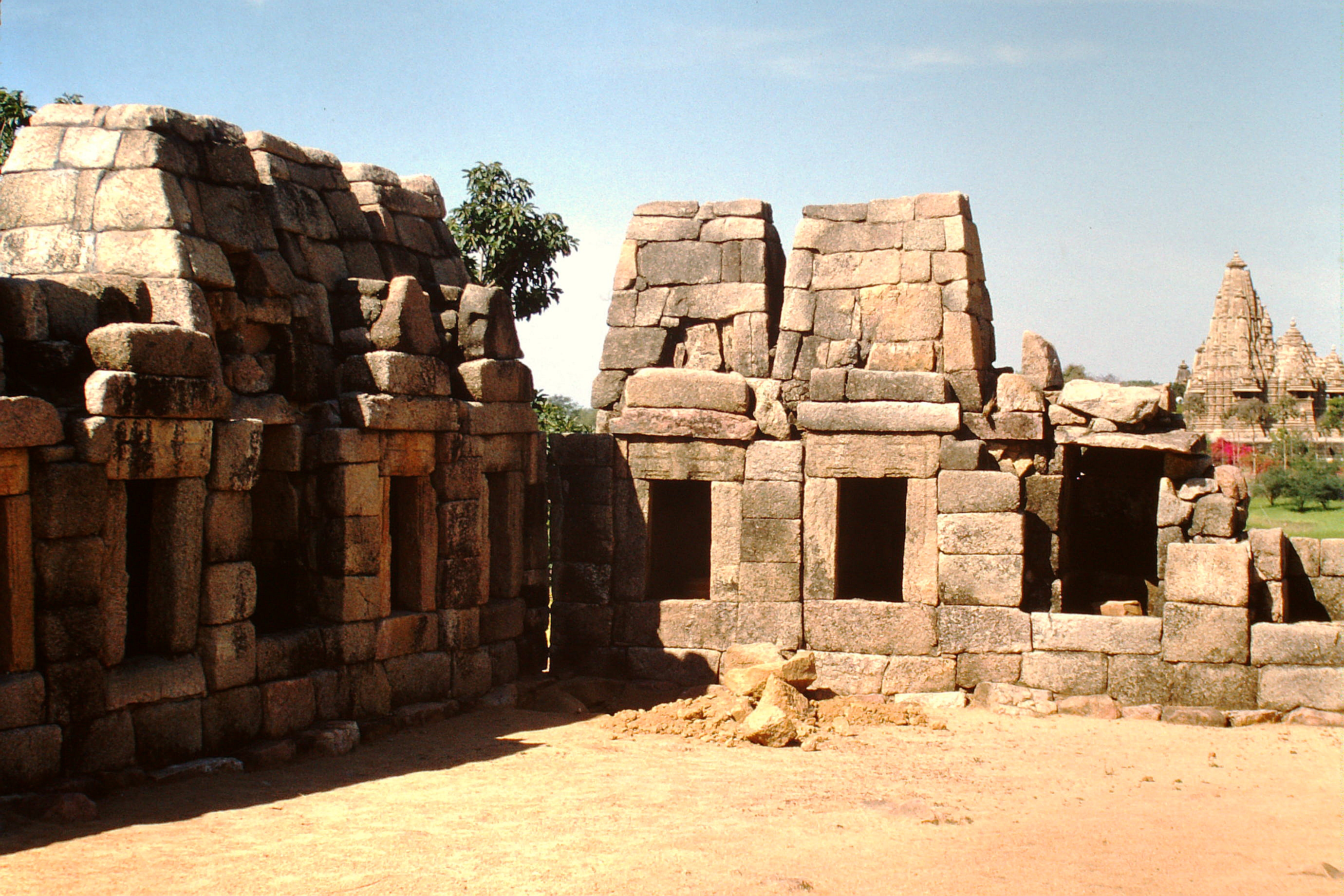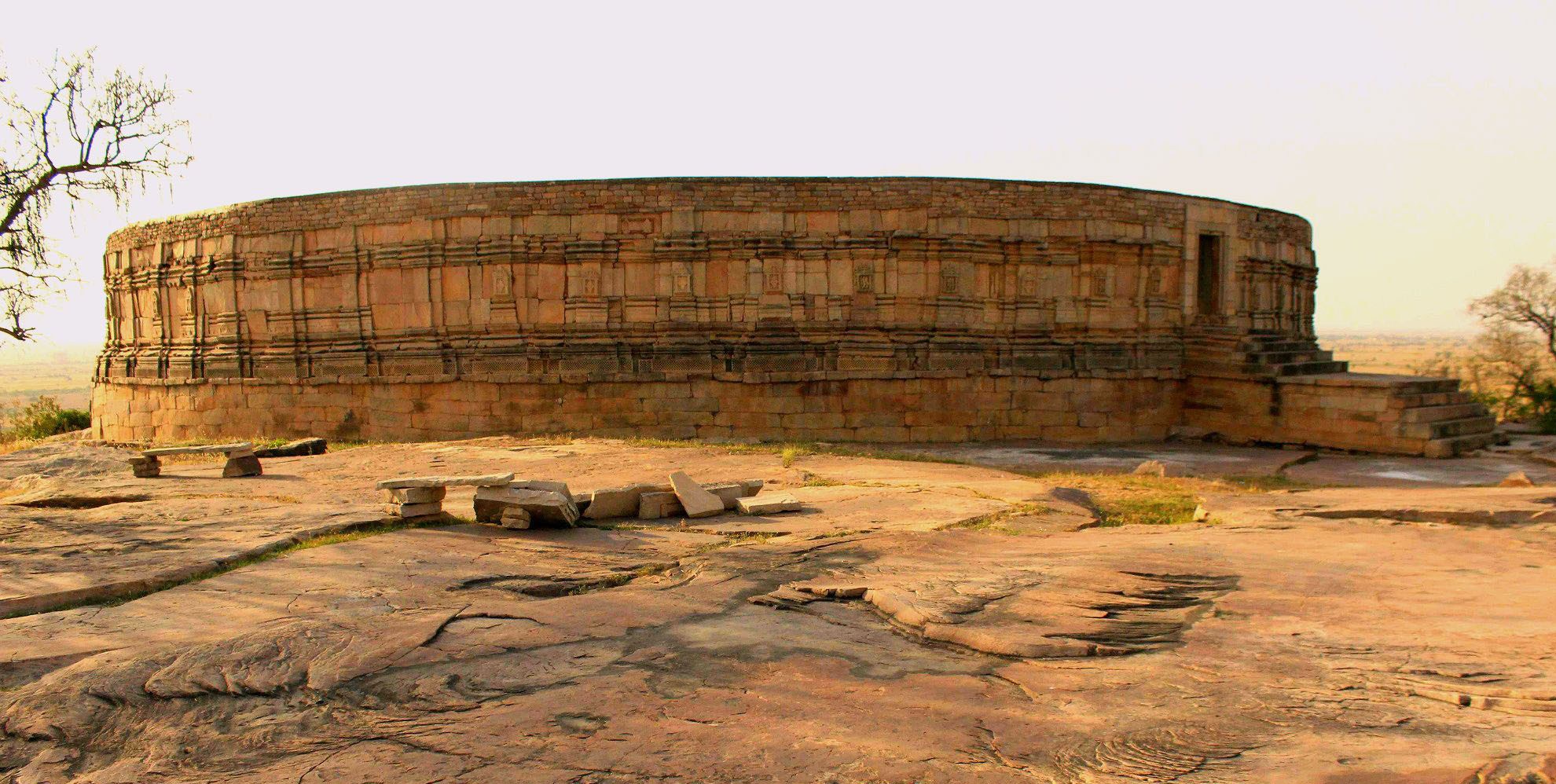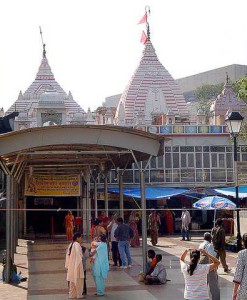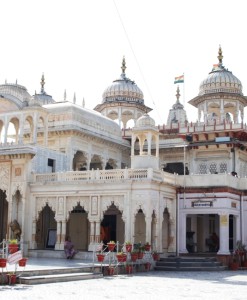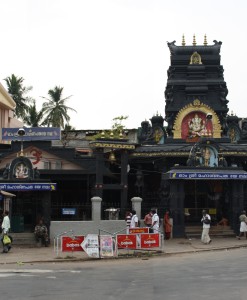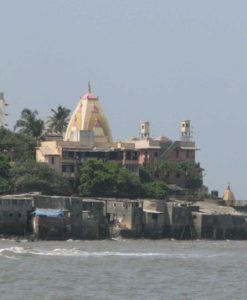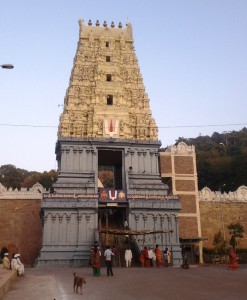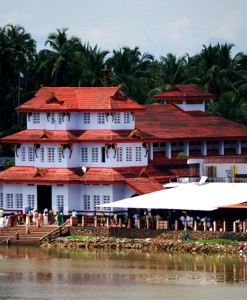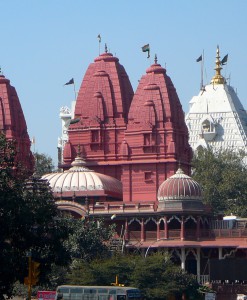No products in the cart.
The Chausath yogini temple, made of coarse granite, is the earliest building at Khajuraho and is situated on a low granite outcrop to the southwest of the Siva-Sagar tank. It is an open-air quadrangular structure of sixty-seven peripheral shrines, of which only thirty-five have now survived. The Temple is built on a large raised podium which itself is set in an open courtyard with small temples surrounding it. It is these shrines that are devoted to the Yoginis.
The shrines are tiny plain cells, each entered by a small doorway and roofed by a curvilinear shikhara of an elementary form. The shrine in the back wall, facing the entrance, is the largest and perhaps constituted the main shrine. A few simple moldings on the façade are all the decoration that the temple displays, but in spite of its uncouth appearance and rugged bareness, it possesses an elemental strength and reveals some basic traits of Khajuraho style, such as a lofty platform and a jangha (wall) divided into two registers. Of all the yogini temples in India, this is the most primitive in construction and unique in being quadrangular and not circular on plan.
The three surviving images, representing Brahmani, Mahesvari and Hingalaja (Mahishamardini) are massive and squat in form and are among the oldest sculptures of Khajuraho. The latter two are inscribed as Mahesvari and Hingalaja. The evidence of the sculptural and architectural style, coupled with the early paleography of the short labels on the images, indicates that the temple is probably datable to the last quarter of the ninth century.
The other Chausath Yogini Temples in India are
- Chausath Yogini, Western Group Khajuraho, Madhya Pradesh. Dated 9th Century AD
- Chausath Yogini, Hirapur near Bhubaneswar, Odisha, Dated 9th Century AD
- Chausath Yogini, Ranipur near Bolangir, Orissa, Dated 9th Century AD
Chausath Yogini Temple, Khajuraho,Madhya Pradesh
The history of this temple dates back to centuries. 9th century A.D. is roughly predicted to be the time of establishment of Chausath Yogini Temple in Khajuraho, India. This ancient link makes Chausath Yogini Temple one of the prime Tourist Attractions in Khajuraho that draws tourists in large numbers from various parts of the world every year.
It takes approximately 1 to 2 hours to visit through all spots of the temple in the campus.
The ideal time to visit Khajuraho is between the months of July and March, however, depending on what you want to do, here’s a monthly breakup of Khajuraho’s climatic conditions so that one can plan accordingly.
October to February: These months comprise the winter season in Khajuraho and can be considered as the best time for outdoor tourist activities especially the temple tours. The peak winter season starts from January and sometimes the temperature can drop as low as 4 degree Celsius, but you can enjoy the winter sun during the afternoon. Also, February is a good time to plan a visit because this is when one can catch the most-awaited dance festival.
March to June: These months constitute the summer season in Khajuraho. While the weather in March is quite pleasant and comfortable for a city tour. April and May can be hot, especially during afternoons when the maximum temperature can go up till 47 degree Celsius. It is advisable to wear light cotton clothes and carry sunscreen to avoid a tan.
July to September: The monsoon season in Khajuraho has its own charm when the lush green area surrounding this small town turns into a real paradise. The humidity is on a high, but the evenings are generally pleasant. Because this is considered off-season for tourists, this is a great time to avail discounts on luxury and boutique hotels.
By Road
Most of the cities in Madhya Pradesh are well-connected with Khajuraho owing to a good road network. The main highway is National Highway Number 75, which falls en route to the town. One can drive in his own vehicle as the roads are quite smooth in Madhya Pradesh.
Khajuraho is well connected with a good bus network. Many private and state-owned buses run from Khajuraho to neighbouring cities like Jhansi. You can choose from a regular bus, non-air-conditioned bus, air-conditioned, semi-deluxe and deluxe buses. The bus fare would depend on the type of bus and the number of kilometres covered.
By Rail
Khajuraho railway station is connected to a few towns only including New Delhi. One can take Khajuraho-Hazrat Nizamuddin Express, which has daily connectivity to Khajuraho. There are various services of tourists to hire a cab or an auto from outside the railway station. The second nearest railhead, which is well-connected with some of the Indian cities is the Mahoba Junction, which is approximately 75 kilometres away from Khajuraho. Some of the regular trains are Bundelkhand Express, Mahakaushal Express and Udaipur Khajuraho Express. Outside the Mahoba Junction, there are cabs or taxis which will drive tourists till Khajuraho.By Air
By Air
Khajuraho has its own domestic airport, which is well-connected to most of the Indian cities such as New Delhi, Mumbai, Varanasi, Allahabad and Bhopal. Some of the popular carriers that have regular flights to Khajuraho are Jet Airways, SpiceJet, Air India and JetKonnect. Since Khajuraho is a very small town, once one reaches the airport, he can hire a cab or a taxi.

